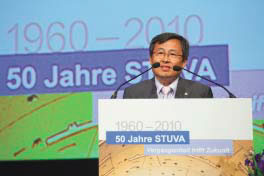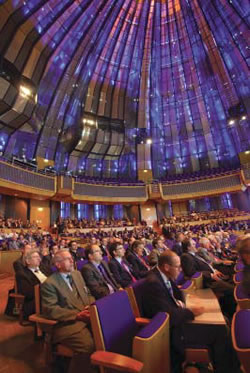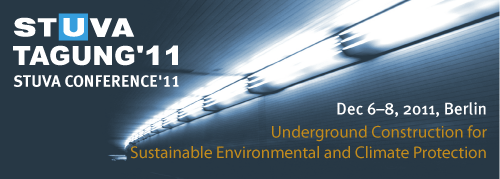
4 DAUB members took part in the annual traditional D-A-CH-meeting 2010 involving Germany (D), Austria (A) and Switzerland (CH). The host was Switzerland. The meeting took place in Zürich and was attended also by 18 Austrian and 12 Swiss colleagues. The ½ day technical seminar dealt with characteristics of urban tunnelling. Main topics were technical as well as contractual items. The additional technical tour led to the Zurich cross-city link including the Weinberg tunnel, which crosses the river Limmat.

Jubilee Event: 50 Years of STUVA 1960 to 2010 – The Past meets the Future
"Past meets future," was the theme from June 17 to 18 2010 in the Tonhalle in Düsseldorf. STUVA held a special conference there to celebrate its 50th anniversary. More than 550 representatives from government, academia and industry, friends and supporters of the STUVA had gathered to hear the high-profile lectures, and had a review on the eventful past of the association and discussed the perspectives to the future of underground construction.
 The jubilee event was opened by Prof. Dr.-Ing. Martin Ziegler, Chairman of the board of STUVA e. V. After his short address a "Youth Forum" followed, during which young tunnellers passed on aspects dealing with the fascination of tunnelling. The best lecturer in this Forum, Jan-Niklas Franzius, took the prize for his contribution "Geothermal Use of TBM-driven Tunnels". This prize for up-and-coming talents was awarded by STUVA for the first time.
The jubilee event was opened by Prof. Dr.-Ing. Martin Ziegler, Chairman of the board of STUVA e. V. After his short address a "Youth Forum" followed, during which young tunnellers passed on aspects dealing with the fascination of tunnelling. The best lecturer in this Forum, Jan-Niklas Franzius, took the prize for his contribution "Geothermal Use of TBM-driven Tunnels". This prize for up-and-coming talents was awarded by STUVA for the first time.
In the afternoon leading experts presented papers during the first, forward-looking part of the celebrations, entitled "The Future of Underground Construction" relating to the significance of the Alpine Base Tunnels for transportation, about the possibilities and limits of driving activities right up to the importance of underground construction for urban development and operating Metro trains by automatic means.
Afterwards high-ranking representatives from national and regional public bodies, including Prof. In-Mo Lee, President of the International Tunnelling and Underground Space Association, gave welcoming addresses.
The second day was devoted to Düsseldorf’s Wehrhahn Line. Five representatives of the companies involved presented papers explaining this remarkable project. After a lunch at the invitation of the Wehrhahn Line JV’s, participants of the event had the chance to visit the sites.

DAUB run 6 working groups during 2010:
- Financing of tunnels via PPP/BOT-projects
- Recommendations for the selection of appropriate TBMs
- Recommendations for designing prefabricated tunnel lining segments
- Recommendations for contracts with low potential for conflicts
- Requirements for protective and emergency cabins on underground worksites (update)
- External communication of DAUB
These working groups are of temporary nature and will be closed as soon as they have finished their special tasks. Members of these working groups are mostly also members of DAUB, but specialists from outside are also involved in some cases.
The results of the working groups are published in technical journals, preferably in "Tunnel" (www.tunnel-online.info), but sometimes also in the German handbook of tunnelling (edited annually).
The following excerpt shows some major tunnelling projects which were running in Germany during 2010:
19 km of double track high speed railway lines (250 to 300 km/h): between Karlsruhe and Basel; partly upgraded and partly replaced, integrating two major bored tunnel projects of 9 and 6 km respectively in length. Each tunnel consists of two parallel single tubes with about 10.5 m excavation diameter. Inauguration is planned for 2011 to improve the traffic connections between Northern and Southern Europe via Lötschberg and Gotthard base tunnels in Switzerland.
30 km double track tunnels on the new/upgraded high-speed line between Nuremberg and Erfurt with Eierberg (3.8 km) and Brandkopf (1.5 km) tunnels as freshly tackled projects. These tunnels – like the majority of the tunnels for the DB high-speed routes – are mainly built by conventional means. The Finne Tunnel (6.9 km) between Erfurt and Leipzig, whose 2 tubes were excavated by shield drivage, forms an exception. Blessberg Tunnel (8.3 km) and Silberberg Tunnel (7.4 km; both part of the Nuremberg-Erfurt high speed line) are major tunnel projects that are still under construction.

